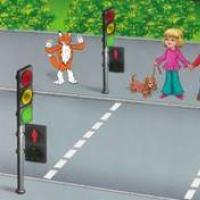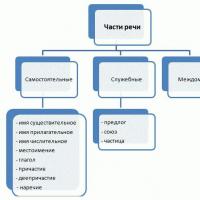The game is a presentation of "Find a brother" to distinguish between soft and hard consonants. Presentation "Determining the position of sound" Game - presentation "Find a brother" to distinguish between soft and hard consonants
Speech therapist: Chepkasova A.S. (Slide #1)
The problem of preparing children with speech disorders for school is relevant today, and in modern methodological literature the process of developing sound analysis skills is not covered enough. The first attempts to consciously isolate a sound from a word, and then to establish the exact place of a particular sound, are necessary prerequisites for learning to read and write. According to V.K. Orfinskaya, the isolation of sound from a word appears in children preschool age spontaneously, complex forms of sound analysis need to be taught specifically. A.N. Gvozdev notes that "although the child notices the difference in individual sounds, he does not independently decompose words into sounds." And indeed, independently highlighting the last consonant sound in a word, several vowels at the same time, setting the position of a given sound or the number of syllables is hardly available to a preschooler. And it is very important that this assistance be qualified, holistic, phased.
Children with speech disorders have difficulties in sound pronunciation, phonemic perception, a pronounced lag in the formation of vocabulary, grammatical structure and coherent speech. The presence of gaps in the development of phonetics, vocabulary, grammatical structure and coherent speech is a serious obstacle in mastering the program kindergarten. A necessary step in mastering literacy is the formation of a sound analysis of the word.
When learning sound analysis a strict sequence in the presentation of the forms of sound analysis should be observed. According to the program of Filicheva, Chirkina, teaching children sound analysis involves the following steps:
(Slide #2)
1st stage sound extraction from words:
Words are pronounced slowly - sound stands out [R] from the words: grrrusha, gorrroh, cucumber, rooster (THIS WORD DOES NOT HAVE A DESIGNATED SOUND)
At the second stage, we learn to determine the place of sound in a word: 1-beginning of a word, middle of a word, end of a word. (Slide #3)
Children are offered games where they need to find and designate the place of sound in a word. (1-beginning, 2-middle, 3-end) token symbol.
(Slide number 4) At the third stage, tokens are introduced to perform sound analysis: red tokens represent vowels, blue - hard consonants, green - soft consonants.
(Slide number 5) at this stage, children are offered games, for example: "Sound tree" leaves of blue, green and red color grow on 3 wonderful trees. The children are given pictures. The child identifies the first sound and tells where the word "grows". Example: the word "car" on a tree with blue leaves, because the first sound in the word is a consonant, hard.
(Slide number 6) Also, children are given a graphic image of the sound composition of the word. For example:
Let's take the word onion. Children pronounce the word "Llluk" . First sound - [L]. "Luuuk" , second sound [U]. The third - [TO]. Each sound is described.
(Slide number 7-8) Then we offer the children pictures to which they must make a sound analysis of the word. (shown in the picture) using chips (characters).
"Games in teaching literacy to preschoolers" - Name the words and the place of the sound "Z". In a white sundress, she stood in a clearing. Solve the riddle. Zoya revealed. How many syllables are there in a word. KVN game. Words that have the syllable “FOR” in their names. What common. What do clue words have in common? Remember the words of the songs with the sound "Z". Come up with sentences according to the diagram for the picture. Brother and brother live across the path.
"Speech therapy games" - Development of thinking and enrichment of vocabulary. Making words from letters. Rugs. The development of visual attention. Sound-letter synthesis. Syllabic domino. Letter games. Games. Chineward "Ladder". Unravel the syllables. Sound-letter analysis. The purpose of speech therapy games.
"Games for the development of logical thinking" - Goals and objectives. Relevance. Games with counting sticks. Development of logical thinking. Constructors, puzzles. Construct two triangles of five sticks. Restore the sequence of events. Diagnosis of children's knowledge. Lotto "My favorite fairy tales". Logical thinking and didactic game. Educational game "logic and counting".
"Logic-mathematical games for preschoolers" - River of time. Project implementation. Project type. Princess Ziferka. Fairy man Geometric. Whale. Cheerful man Palochkin. Intellectual development of preschool children. Forest of mysteries. Tsifrograd. Tasks of logical and mathematical development. Island of Enchanted Stones. Games for the development of imagination. Vietnamese game.
"Folk games for children" - "Fishing rod". "Egg rolling" (Wheels). "Earth-Water-Sky". "Cats and mice". Games that reflect the relationship of man to nature. Folk games. Seasonal rituals. "Lock". Folk games are games that have come to us from very ancient times. Competitive games. Games are traps. household games. Classification of folk games.
"Developing games for preschoolers" - Games and exercises that contribute to the development of memory. The influence of games on the development of mental processes. Recommendations for teachers on the development of perception. Recommendations for teachers to work with children on the development of thinking. At preschool age, the game is the leading activity of the child. Recommendations for teachers to work with children on the development of memory.
There are 13 presentations in total in the topic
Favzana Ayupova
Game - presentation "Find a brother" to distinguish between soft and hard consonants
Game - presentation"Find a brother" on the distinguish between soft and hard consonants.
The game can be played with children of 5 years old in the joint activity of the teacher with children, both individually and in a subgroup with 3-5 children.
Target games:
to form the ability to intonate the first sound in a word and differentiate consonants by hardness and softness.
At there are also brothers of sounds. Large brother - hard consonant, but small brother - soft consonant sound. To find brother, you need to highlight the first sound in a word and find it brother in the second column. Under the blue box are words that begin with "big brother" (with hard consonant sound) . In the second column, under the green square (words starting with soft consonant sound) .
First you need to say the name of the words-pictures so that there is no double interpretation of the words (boat, house, dress, dove and pyramid, guitar, woodpecker, lemon). Then, in turn, from top to bottom, we begin to search for words brothers. Whoever found it first clicks LMB - the picture moves to " brother"



